Hydrogen Production from Biogas: Development of an Efficient Nickel Catalyst by the Exsolution Approach
Abstract
1. Introduction
2. Materials and Methods
2.1. Catalyst Preparation
2.2. Catalyst Characterization
2.3. Catalyst Testing
3. Results and Discussion
3.1. Synthesis of Catalysts
3.2. Characterization of the Catalysts before Reaction
3.3. Catalytic Measurements
3.4. Characterization of the Catalysts after Reaction
4. Conclusions
Author Contributions
Funding
Data Availability Statement
Acknowledgments
Conflicts of Interest
References
- BP World Energy. BP Statistical Review of World Energy, 71st ed.; BP Stat Rev World Energy: London, UK, 2022; pp. 1–60. [Google Scholar]
- IEA. World Energy Outlook 2021; IEA: Paris, France, 2021. [Google Scholar]
- IEA. World Energy Outlook 2022; IEA: Paris, France, 2022. [Google Scholar]
- Syvitski, J.; Waters, C.N.; Day, J.; Milliman, J.D.; Summerhayes, C.; Steffen, W.; Zalasiewicz, J.; Cearreta, A.; Gałuszka, A.; Hajdas, I.; et al. Extraordinary human energy consumption and resultant geological impacts beginning around 1950 CE initiated the proposed Anthropocene Epoch. Commun. Earth Environ. 2020, 1, 1–13. [Google Scholar] [CrossRef]
- The Royal Society; U.S. National Academy of Sciences. Climate Change; National Academies Press: Washington, DC, USA, 2020. [Google Scholar] [CrossRef]
- Singh, D.B.R. Global Warming—Impacts and Future Perspectives; InTech: London, UK, 2012. [Google Scholar] [CrossRef]
- Solomon, S.; Plattner, G.-K.; Knutti, R.; Friedlingstein, P. Irreversible climate change due to carbon dioxide emissions. Proc. Natl. Acad. Sci. USA 2009, 106, 1704–1709. [Google Scholar] [CrossRef] [PubMed]
- IEA. Energy Technology Perspectives 2023; IEA: Paris, France, 2023. [Google Scholar] [CrossRef]
- Benghanem, M.; Mellit, A.; Almohamadi, H.; Haddad, S.; Chettibi, N.; Alanazi, A.M.; Dasalla, D.; Alzahrani, A. Hydrogen Production Methods Based on Solar and Wind Energy: A Review. Energies 2023, 16, 757. [Google Scholar] [CrossRef]
- Liu, H.; Ampah, J.D.; Zhao, Y.; Sun, X.; Xu, L.; Jiang, X.; Wang, S. A Perspective on the Overarching Role of Hydrogen, Ammonia, and Methanol Carbon-Neutral Fuels towards Net Zero Emission in the Next Three Decades. Energies 2022, 16, 280. [Google Scholar] [CrossRef]
- Hren, R.; Vujanović, A.; Van Fan, Y.; Klemeš, J.J.; Krajnc, D.; Čuček, L. Hydrogen production, storage and transport for renewable energy and chemicals: An environmental footprint assessment. Renew. Sustain. Energy Rev. 2023, 173, 113113. [Google Scholar] [CrossRef]
- Hosseini, S.E.; Wahid, M.A. Hydrogen production from renewable and sustainable energy resources: Promising green energy carrier for clean development. Renew. Sustain. Energy Rev. 2016, 57, 850–866. [Google Scholar] [CrossRef]
- Matus, V.; Ismagilov, I.; Mikhaylova, E.; Ismagilov, Z. Hydrogen Production from Coal Industry Methane. Eurasian Chem. J. 2022, 24, 69–91. [Google Scholar] [CrossRef]
- Ismagilov, Z.R.; Matus, E.V.; Li, L. Catalytic methods of converting carbon dioxide into useful products to reduce the impact of coal generation on global climate change. Uspekhi Fiz Nauk 2022, 65, 1139–1154. [Google Scholar] [CrossRef]
- IEA. Global Hydrogen Review 2022; IEA: Paris, France, 2022. [Google Scholar] [CrossRef]
- Tian, Q.-Q.; Liang, L.; Zhu, M.-J. Enhanced biohydrogen production from sugarcane bagasse by Clostridium thermocellum supplemented with CaCO3. Bioresour. Technol. 2015, 197, 422–428. [Google Scholar] [CrossRef] [PubMed]
- Kaparaju, P.; Serrano, M.; Thomsen, A.B.; Kongjan, P.; Angelidaki, I. Bioethanol, biohydrogen and biogas production from wheat straw in a biorefinery concept. Bioresour. Technol. 2009, 100, 2562–2568. [Google Scholar] [CrossRef] [PubMed]
- Agyekum, E.B.; Nutakor, C.; Agwa, A.M.; Kamel, S. A Critical Review of Renewable Hydrogen Production Methods: Factors Affecting Their Scale-Up and Its Role in Future Energy Generation. Membranes 2022, 12, 173. [Google Scholar] [CrossRef] [PubMed]
- Gao, Y.; Gao, R.; Zhang, G.; Zheng, Y.; Zhao, J. Oxidative desulfurization of model fuel in the presence of molecular oxygen over polyoxometalate based catalysts supported on carbon nanotubes. Fuel 2018, 224, 261–270. [Google Scholar] [CrossRef]
- Hajjaji, N.; Martinez, S.; Trably, E.; Steyer, J.-P.; Helias, A. Life cycle assessment of hydrogen production from biogas reforming. Int. J. Hydrogen Energy 2016, 41, 6064–6075. [Google Scholar] [CrossRef]
- Gao, Y.; Jiang, J.; Meng, Y.; Yan, F.; Aihemaiti, A. A review of recent developments in hydrogen production via biogas dry reforming. Energy Convers. Manag. 2018, 171, 133–155. [Google Scholar] [CrossRef]
- Chattanathan, S.A.; Adhikari, S.; McVey, M.; Fasina, O. Hydrogen production from biogas reforming and the effect of H2S on CH4 conversion. Int. J. Hydrogen Energy 2014, 39, 19905–19911. [Google Scholar] [CrossRef]
- Awe, O.W.; Zhao, Y.; Nzihou, A.; Minh, D.P.; Lyczko, N. A Review of Biogas Utilisation, Purification and Upgrading Technologies. Waste Biomass- Valorization 2017, 8, 267–283. [Google Scholar] [CrossRef]
- Rasi, S.; Veijanen, A.; Rintala, J. Trace compounds of biogas from different biogas production plants. Energy 2007, 32, 1375–1380. [Google Scholar] [CrossRef]
- Matus, E.; Ismagilov, Z. Promising Directions in Chemical Processing of Methane from Coal Industry. Part 1. Thermodynamic analysis. Eurasian Chem. J. 2022, 24, 203–214. [Google Scholar] [CrossRef]
- Matus, E.V.; Sukhova, O.B.; Ismagilov, I.Z.; Kerzhentsev, M.A.; Li, L.; Ismagilov, Z.R. Bi-reforming of methane: Thermodynamic equilibrium analysis and selection of preferable reaction conditions. J. Phys. Conf. Ser. 2021, 1749, 012023. [Google Scholar] [CrossRef]
- Liu, J.; Zhu, X.; Li, X.; Li, K.; Shi, C.; Zhu, A. Effect of O2/CH4 ratio on the optimal specific-energy-input (SEI) for oxidative reforming of biogas in a plasma-shade reactor. J. Energy Chem. 2013, 22, 681–684. [Google Scholar] [CrossRef]
- Chen, X.; Jiang, J.; Li, K.; Tian, S.; Yan, F. Energy-efficient biogas reforming process to produce syngas: The enhanced methane conversion by O2. Appl. Energy 2017, 185, 687–697. [Google Scholar] [CrossRef]
- Phromprasit, J.; Powell, J.; Wongsakulphasatch, S.; Kiatkittipong, W.; Bumroongsakulsawat, P.; Assabumrungrat, S. H2 production from sorption enhanced steam reforming of biogas using multifunctional catalysts of Ni over Zr-, Ce- and La-modified CaO sorbents. Chem. Eng. J. 2017, 313, 1415–1425. [Google Scholar] [CrossRef]
- Rosset, M.; Féris, L.A.; Perez-Lopez, O.W. Biogas reforming to syngas over cu-modified Ni-Al-LDH catalysts. Int. J. Energy Res. 2022, 46, 22664–22678. [Google Scholar] [CrossRef]
- Wang, C.; Zhang, Y.; Wang, Y.; Zhao, Y. Comparative Studies of Non-noble Metal Modified Mesoporous M-Ni-CaO-ZrO2(M = Fe, Co, Cu) Catalysts for Simulated Biogas Dry Reforming. Chin. J. Chem. 2016, 35, 113–120. [Google Scholar] [CrossRef]
- Charisiou, N.D.; Baklavaridis, A.; Papadakis, V.G.; Goula, M.A. Synthesis Gas Production via the Biogas Reforming Reaction Over Ni/MgO–Al2O3 and Ni/CaO–Al2O3 Catalysts. Waste Biomass-Valoriz. 2016, 7, 725–736. [Google Scholar] [CrossRef]
- Xu, J.; Zhou, W.; Li, Z.; Wang, J.; Ma, J. Biogas reforming for hydrogen production over nickel and cobalt bimetallic catalysts. Int. J. Hydrogen Energy 2009, 34, 6646–6654. [Google Scholar] [CrossRef]
- Chen, X.; Jiang, J.; Yan, F.; Li, K.; Tian, S.; Gao, Y.; Zhou, H. Dry Reforming of Model Biogas on a Ni/SiO2 Catalyst: Overall Performance and Mechanisms of Sulfur Poisoning and Regeneration. ACS Sustain. Chem. Eng. 2017, 5, 10248–10257. [Google Scholar] [CrossRef]
- Chen, X.; Jiang, J.; Tian, S.; Li, K. Biogas dry reforming for syngas production: Catalytic performance of nickel supported on waste-derived SiO2. Catal. Sci. Technol. 2014, 5, 860–868. [Google Scholar] [CrossRef]
- Gaillard, M.; Virginie, M.; Khodakov, A.Y. New molybdenum-based catalysts for dry reforming of methane in presence of sulfur: A promising way for biogas valorization. Catal. Today 2017, 289, 143–150. [Google Scholar] [CrossRef]
- Serrano-Lotina, A.; Rodríguez, L.; Muñoz, G.; Martin, A.; Folgado, M.; Daza, L. Biogas reforming over La-NiMgAl catalysts derived from hydrotalcite-like structure: Influence of calcination temperature. Catal. Commun. 2011, 12, 961–967. [Google Scholar] [CrossRef]
- Pawar, V.; Appari, S.; Monder, D.S.; Janardhanan, V.M. Study of the Combined Deactivation Due to Sulfur Poisoning and Carbon Deposition during Biogas Dry Reforming on Supported Ni Catalyst. Ind. Eng. Chem. Res. 2017, 56, 8448–8455. [Google Scholar] [CrossRef]
- Charisiou, N.; Siakavelas, G.; Papageridis, K.; Baklavaridis, A.; Tzounis, L.; Avraam, D.; Goula, M. Syngas production via the biogas dry reforming reaction over nickel supported on modified with CeO2 and/or La2O3 alumina catalysts. J. Nat. Gas Sci. Eng. 2016, 31, 164–183. [Google Scholar] [CrossRef]
- Chava, R.; Bhaskar, A.V.D.; Roy, B.; Appari, S. Reforming of model biogas using Ni/CeO2/γ-Al2O3 monolith catalyst. Mater. Today Proc. 2023, 72, 134–139. [Google Scholar] [CrossRef]
- Dan, M.; Mihet, M.; Barbu-Tudoran, L.; Lazar, M.D. Biogas upgrading to syngas by combined reforming using Ni/CeO2–Al2O3 with bimodal pore structure. Microporous Mesoporous Mater. 2022, 341, 112082. [Google Scholar] [CrossRef]
- Matus, E.; Sukhova, O.; Kerzhentsev, M.; Ismagilov, I.; Yashnik, S.; Ushakov, V.; Stonkus, O.; Gerasimov, E.; Nikitin, A.; Bharali, P.; et al. Hydrogen Production through Bi-Reforming of Methane: Improving Ni Catalyst Performance via an Exsolution Approach. Catalysts 2022, 12, 1493. [Google Scholar] [CrossRef]
- Matus, E.V.; Nefedova, D.V.; Sukhova, O.B.; Ismagilov, I.Z.; Ushakov, V.A.; Yashnik, S.A.; Nikitin, A.P.; Kerzhentsev, M.A.; Ismagilov, Z.R. Formation and Properties of Ni–Ce–La–O Catalysts of Reforming. Kinet. Catal. 2019, 60, 496–507. [Google Scholar] [CrossRef]
- Matus, E.V.; Ismagilov, I.Z.; Ushakov, V.A.; Nikitin, A.P.; Stonkus, O.A.; Gerasimov, E.Y.; Kerzhentsev, M.A.; Bharali, P.; Ismagilov, Z.R. Genesis and Structural Properties of (Ce1–xMx0.8Ni0.2Oy (M = La, Mg) Oxides. J. Struct. Chem. 2020, 61, 1080–1089. [Google Scholar] [CrossRef]
- Ismagilov, Z.R.; Matus, E.V.; Efimova, O.S.; Khitsova, L.M.; Popova, A.N.; Nikitin, A.P.; Sozinov, S.A. The Development of Metal-Carbon Catalysts for Oxidative Desulfurization of Diesel Fractions. Eurasian Chem. J. 2020, 22, 81–88. [Google Scholar] [CrossRef]
- Matus, E.; Sukhova, O.; Ismagilov, I.; Kerzhentsev, M.; Stonkus, O.; Ismagilov, Z. Hydrogen Production through Autothermal Reforming of Ethanol: Enhancement of Ni Catalyst Performance via Promotion. Energies 2021, 14, 5176. [Google Scholar] [CrossRef]
- Strydom, C.A.; van Vuuren, C.P.J. The thermal decomposition of cerium(III) nitrate. J. Therm. Anal. Calorim. 1987, 32, 157–160. [Google Scholar] [CrossRef]
- Małecka, B.; Łącz, A.; Drożdż, E.; Małecki, A. Thermal decomposition of d-metal nitrates supported on alumina. J. Therm. Anal. Calorim. 2014, 119, 1053–1061. [Google Scholar] [CrossRef]
- Da Silva, M.F.P.; Matos, J.R.; Isolani, P.C. Synthesis, characterization and thermal analysis of 1:1 and 2:3 lanthanide(iii) citrates. J. Therm. Anal. Calorim. 2008, 94, 305–311. [Google Scholar] [CrossRef]
- Wei, Y.; Wang, H.; Li, K.; Zhu, X.; DU, Y. Preparation and characterization of Ce1−x NixO2 as oxygen carrier for selective oxidation methane to syngas in absence of gaseous oxygen. J. Rare Earths 2010, 28, 357–361. [Google Scholar] [CrossRef]
- Matus, E.V.; Vasiliev, S.D.; Ismagilov, I.Z.; Ushakov, V.A.; Kerzhentsev, M.A.; Ismagilov, Z.R. Development of Supported Ni Catalysts for Autothermal Reforming of Methane. Chem. Sustain. Dev. 2020, 28, 403–411. [Google Scholar] [CrossRef]
- Matus, E.V.; Sukhova, O.; Ismagilov, I.; Ushakov, V.; Yashnik, S.; Kerzhentsev, M.; Ismagilov, Z. Steam/CO2 Reforming of Methane Over Impregnated Ni/CeO2 Catalysts: Effect of Sample Composition on Their Activity and Stability. Eurasian Chem. J. 2022, 24, 191–202. [Google Scholar] [CrossRef]
- Sing, K.S.W. Reporting physisorption data for gas/solid systems with special reference to the determination of surface area and porosity (Recommendations 1984). Pure Appl. Chem. 1985, 57, 603–619. [Google Scholar] [CrossRef]
- Matus, E.V.; Okhlopkova, L.B.; Sukhova, O.B.; Ismagilov, I.Z.; Kerzhentsev, M.A.; Ismagilov, Z.R. Effects of preparation mode and doping on the genesis and properties of Ni/Ce1-xMxOy nanocrystallites (M = Gd, La, Mg) for catalytic applications. J. Nanoparticle Res. 2019, 21, 11. [Google Scholar] [CrossRef]
- Matus, E.V.; Shlyakhtina, A.S.; Sukhova, O.B.; Ismagilov, I.Z.; Ushakov, V.A.; Yashnik, S.A.; Nikitin, A.P.; Bharali, P.; Kerzhentsev, M.A.; Ismagilov, Z.R. Effect of Preparation Methods on the Physicochemical and Functional Properties of Ni/CeO2 Catalysts. Kinet. Catal. 2019, 60, 221–230. [Google Scholar] [CrossRef]
- Kostić, R.; Aškrabić, S.; Dohčević-Mitrović, Z.; Popović, Z. Low-frequency Raman scattering from CeO2 nanoparticles. Appl. Phys. A 2007, 90, 679–683. [Google Scholar] [CrossRef]
- Li, L.; Chen, F.; Lu, J.-Q.; Luo, M.-F. Study of Defect Sites in Ce1–xMxO2−δ (x = 0.2) Solid Solutions Using Raman Spectroscopy. J. Phys. Chem. A 2011, 115, 7972–7977. [Google Scholar] [CrossRef]
- Ebrahimi, P.; Kumar, A.; Khraisheh, M. A Review of CeO2 Supported Catalysts for CO2 Reduction to CO through the Reverse Water Gas Shift Reaction. Catalysts 2022, 12, 1101. [Google Scholar] [CrossRef]
- Da Fonseca, R.O.; Ponseggi, A.R.; Rabelo-Neto, R.C.; Simões, R.C.; Mattos, L.V.; Noronha, F.B. Controlling carbon formation over Ni/CeO2 catalyst for dry reforming of CH4 by tuning Ni crystallite size and oxygen vacancies of the support. J. CO2 Util. 2022, 57, 101880. [Google Scholar] [CrossRef]
- Al–Swai, B.M.; Osman, N.B.; Ramli, A.; Abdullah, B.; Farooqi, A.S.; Ayodele, B.V.; Patrick, D.O. Low-temperature catalytic conversion of greenhouse gases (CO2 and CH4) to syngas over ceria-magnesia mixed oxide supported nickel catalysts. Int. J. Hydrogen Energy 2020, 46, 24768–24780. [Google Scholar] [CrossRef]
- Li, P.; Park, Y.H.; Moon, D.J.; Park, N.C.; Kim, Y.C. Carbon Deposition onto Ni-Based Catalysts for Combined Steam/CO2 Reforming of Methane. J. Nanosci. Nanotechnol. 2016, 16, 1562–1566. [Google Scholar] [CrossRef]
- Wysocka, I.; Mielewczyk-Gryń, A.; Łapiński, M.; Cieślik, B.; Rogala, A. Effect of small quantities of potassium promoter and steam on the catalytic properties of nickel catalysts in dry/combined methane reforming. Int. J. Hydrogen Energy 2020, 46, 3847–3864. [Google Scholar] [CrossRef]
- Siang, T.J.; Pham, T.L.; Van Cuong, N.; Phuong, P.T.; Phuc, N.H.H.; Truong, Q.D.; Vo, D.-V.N. Combined steam and CO2 reforming of methane for syngas production over carbon-resistant boron-promoted Ni/SBA-15 catalysts. Microporous Mesoporous Mater. 2018, 262, 122–132. [Google Scholar] [CrossRef]
- Zhao, Z.; Ren, P.; Li, W.; Miao, B. Effect of mineralizers for preparing ZrO2 support on the supported Ni catalyst for steam-CO2 bi-reforming of methane. Int. J. Hydrog. Energy 2017, 42, 6598–6609. [Google Scholar] [CrossRef]
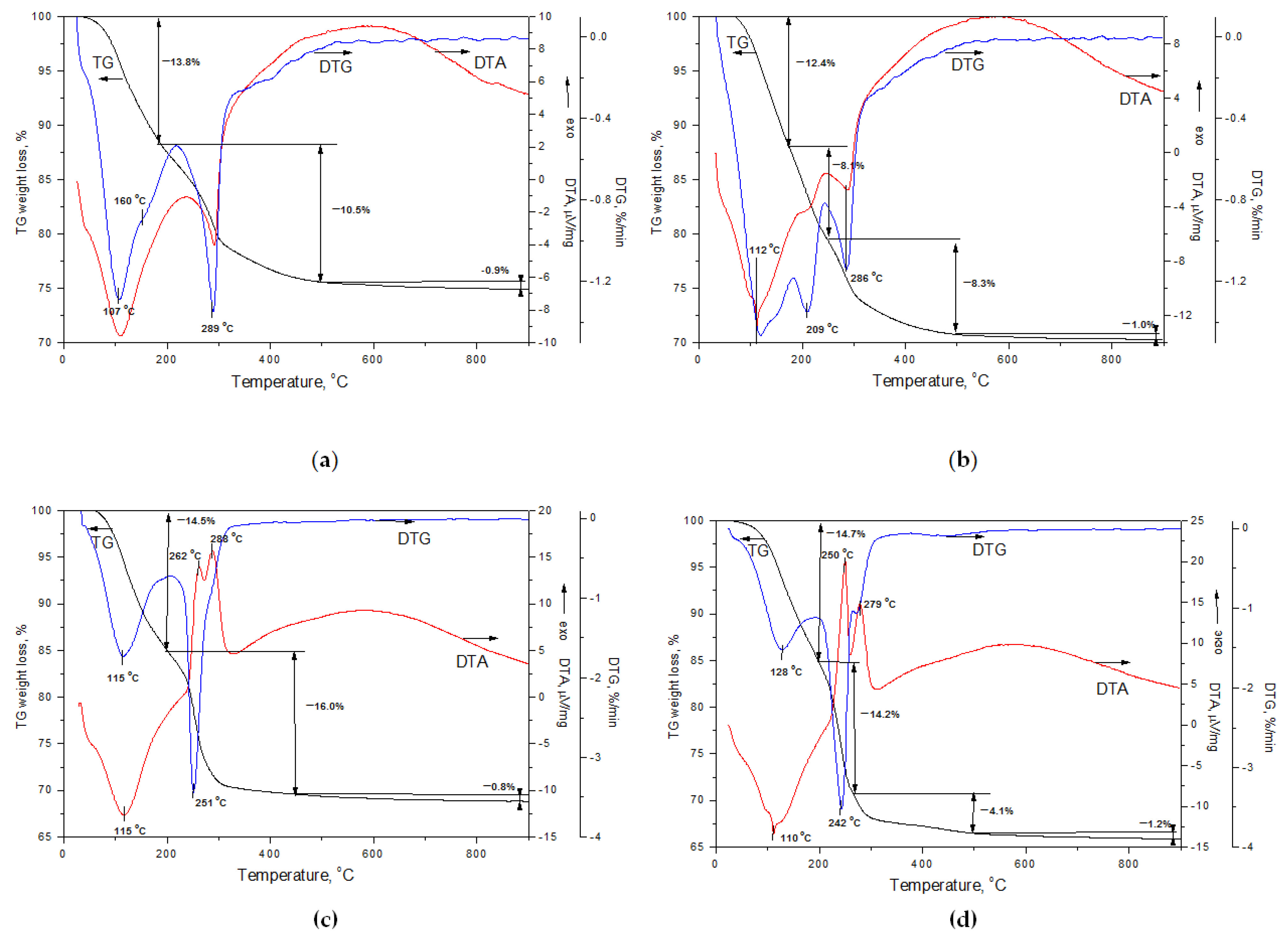
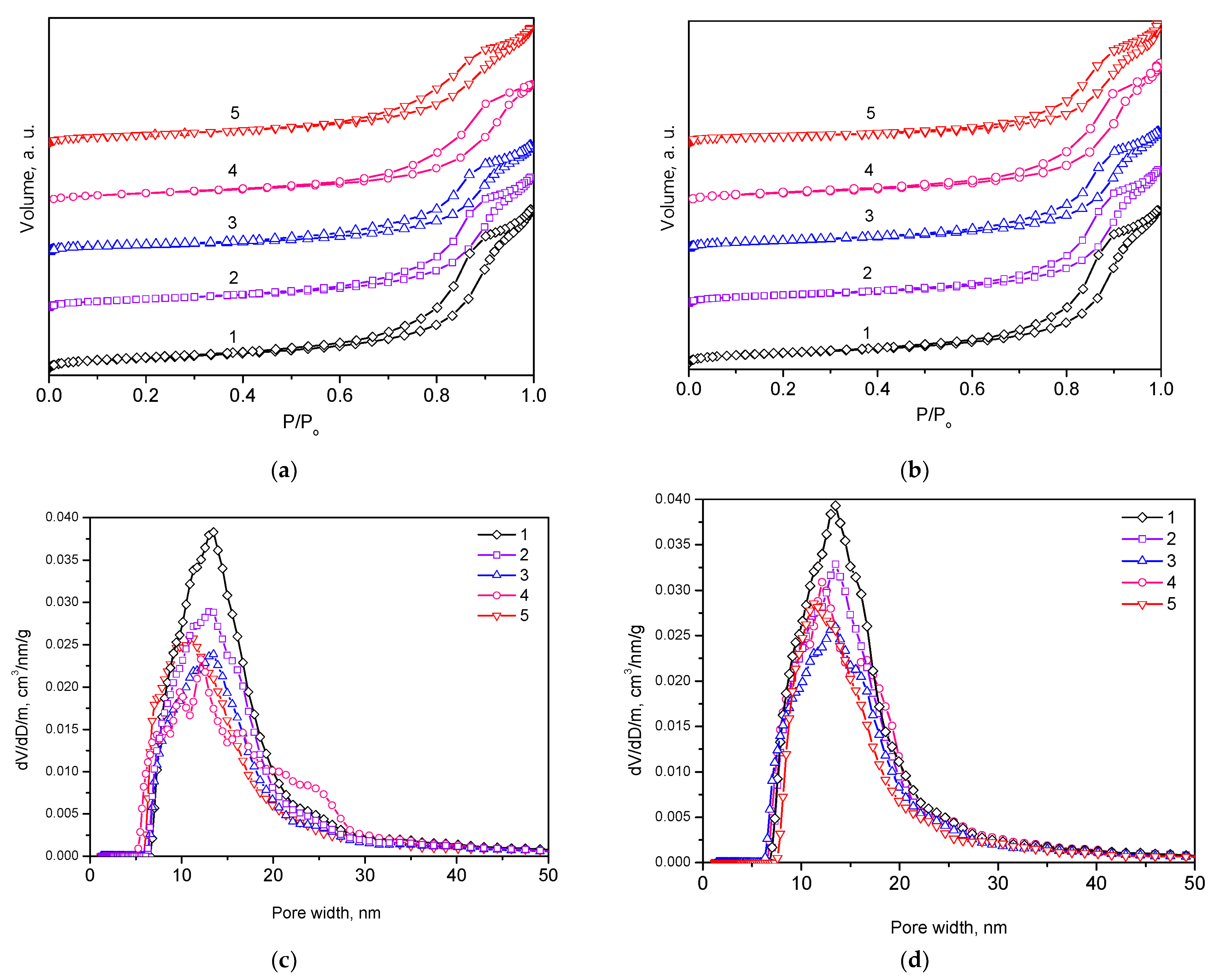
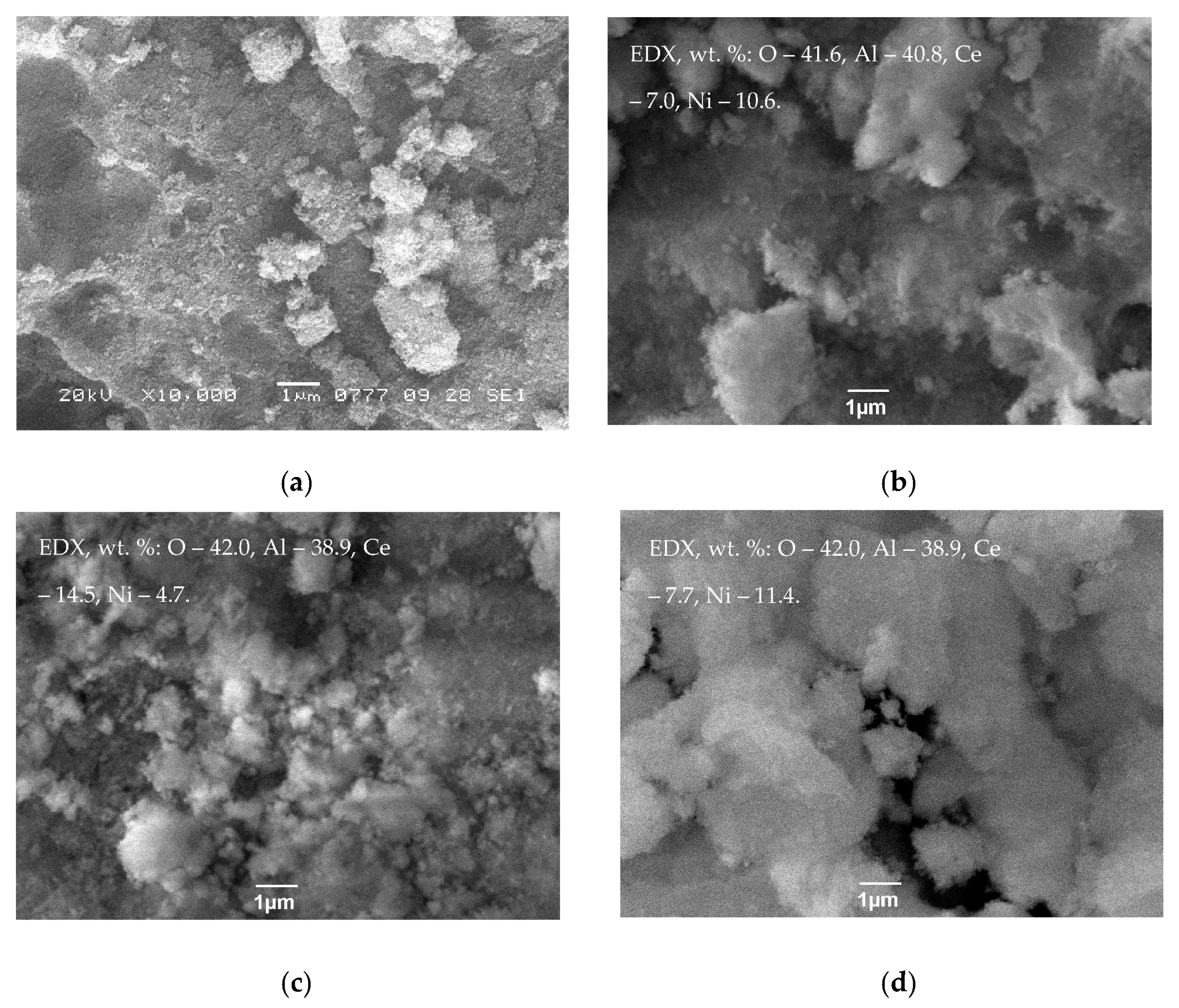
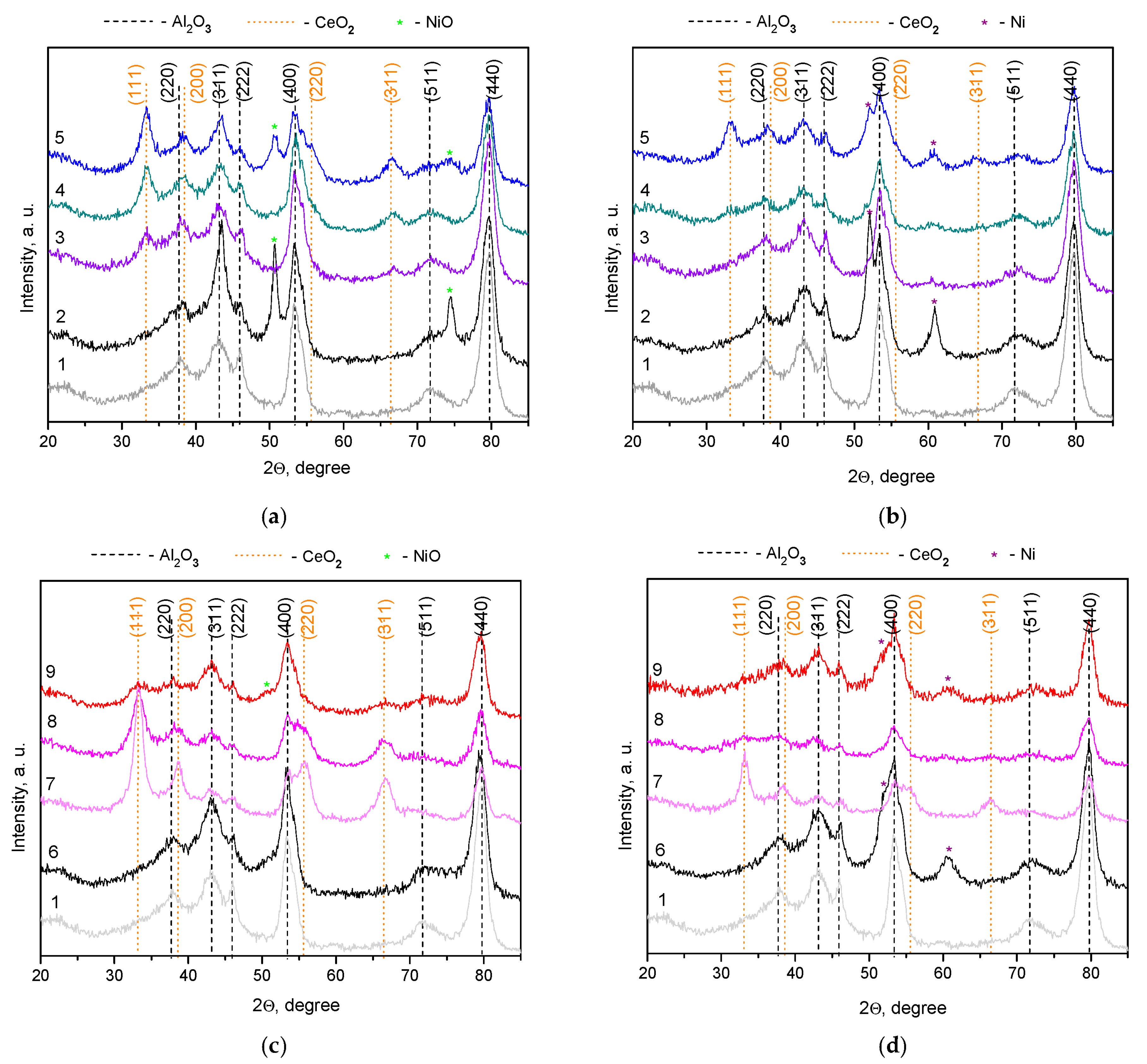
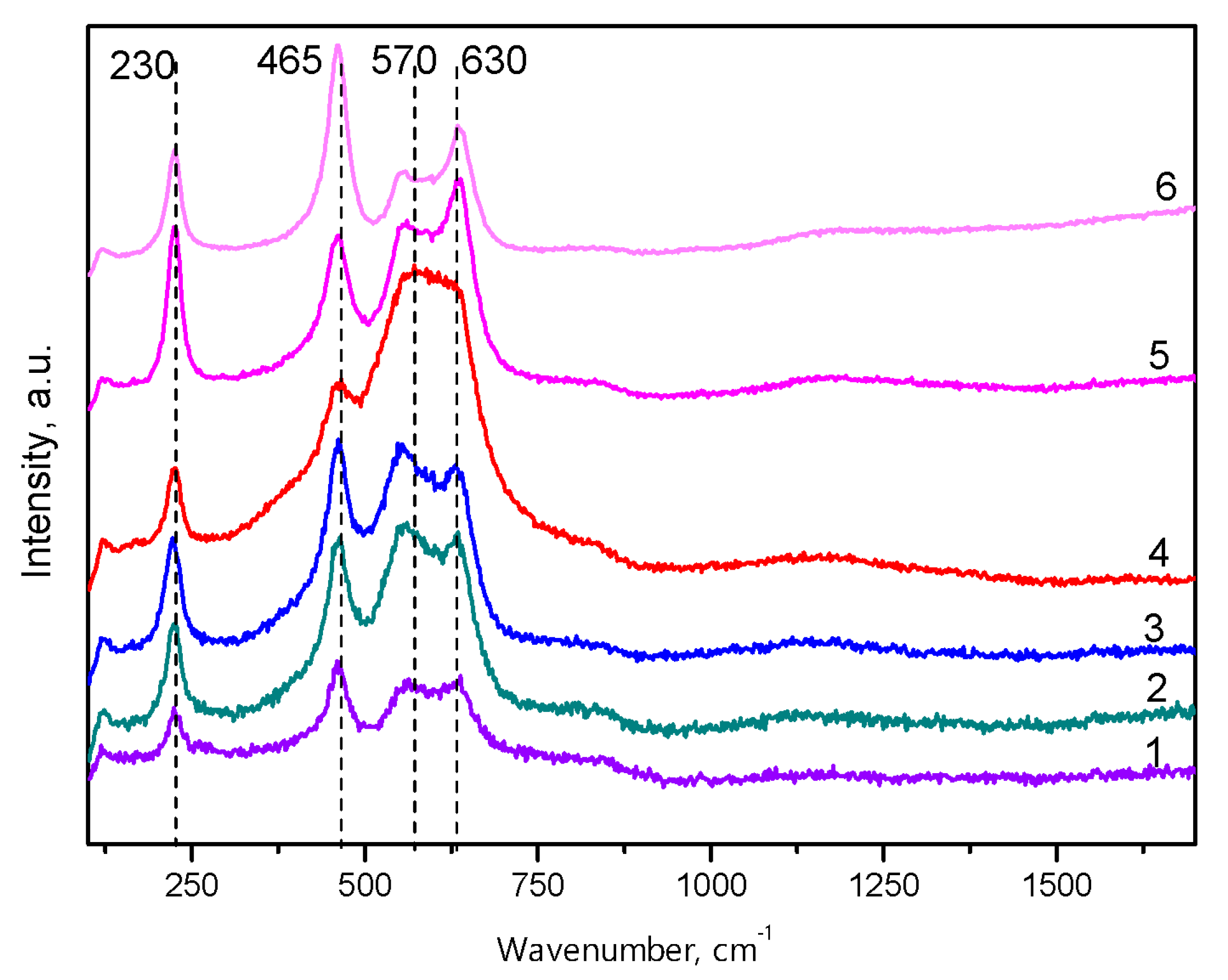
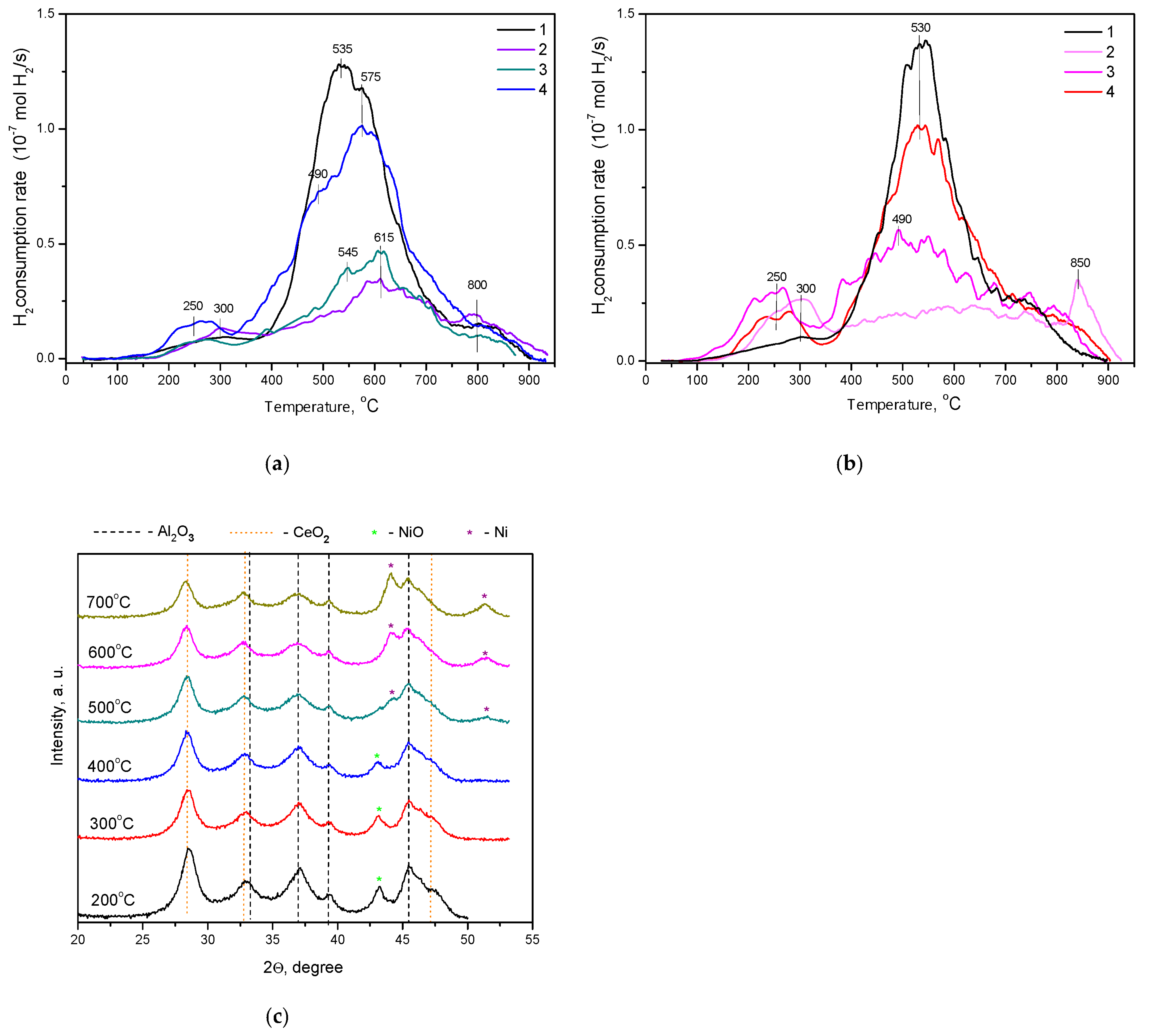
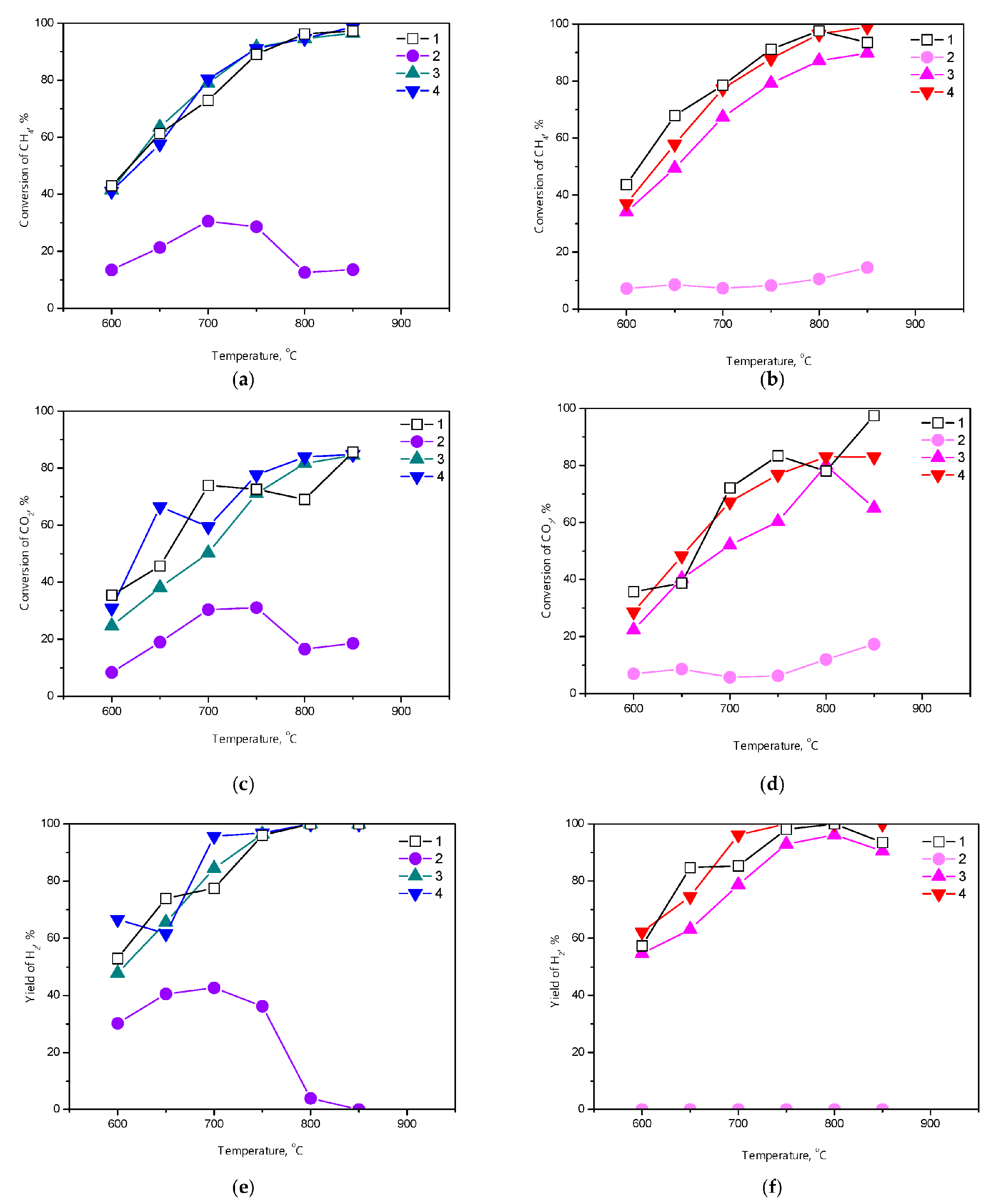
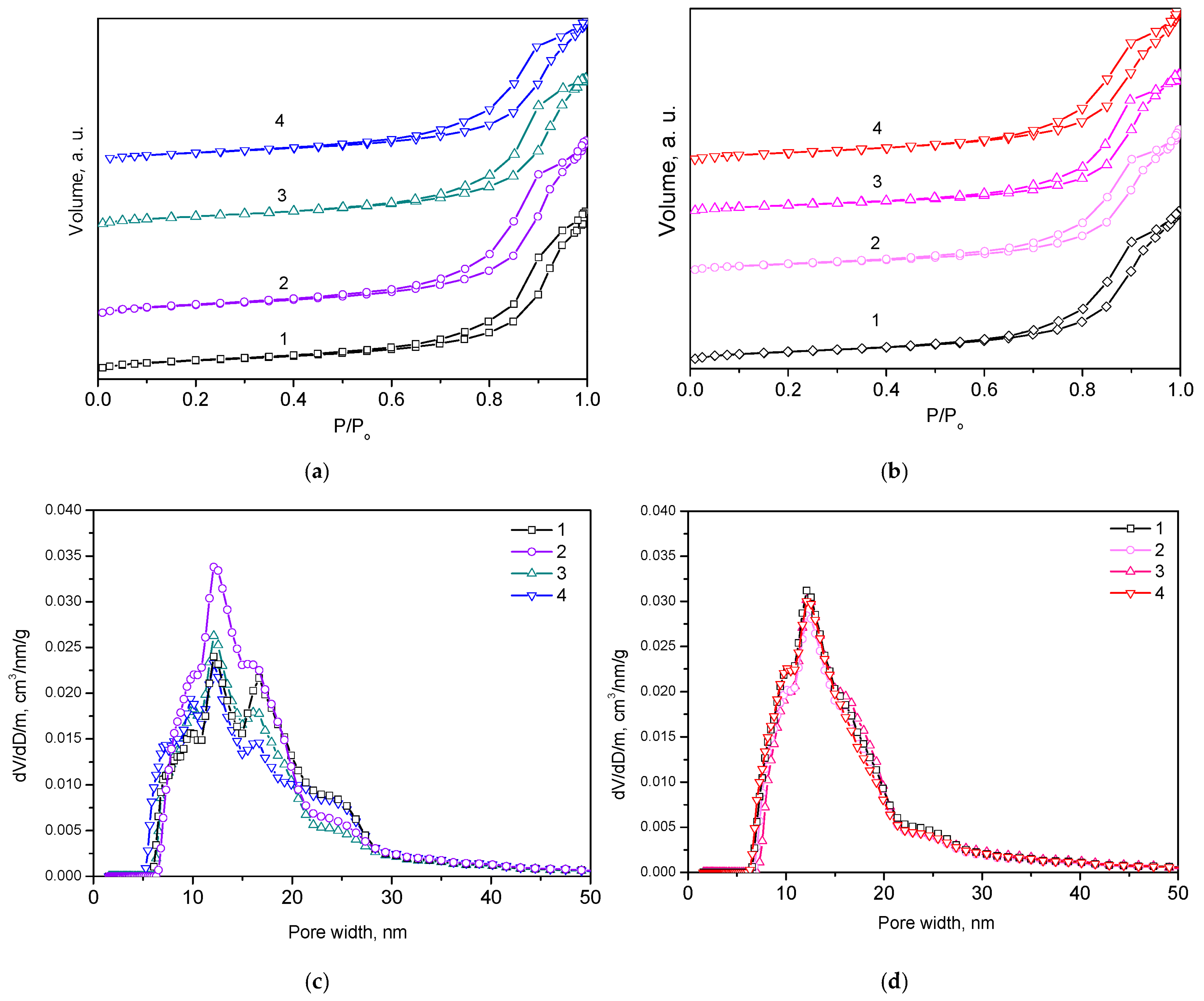
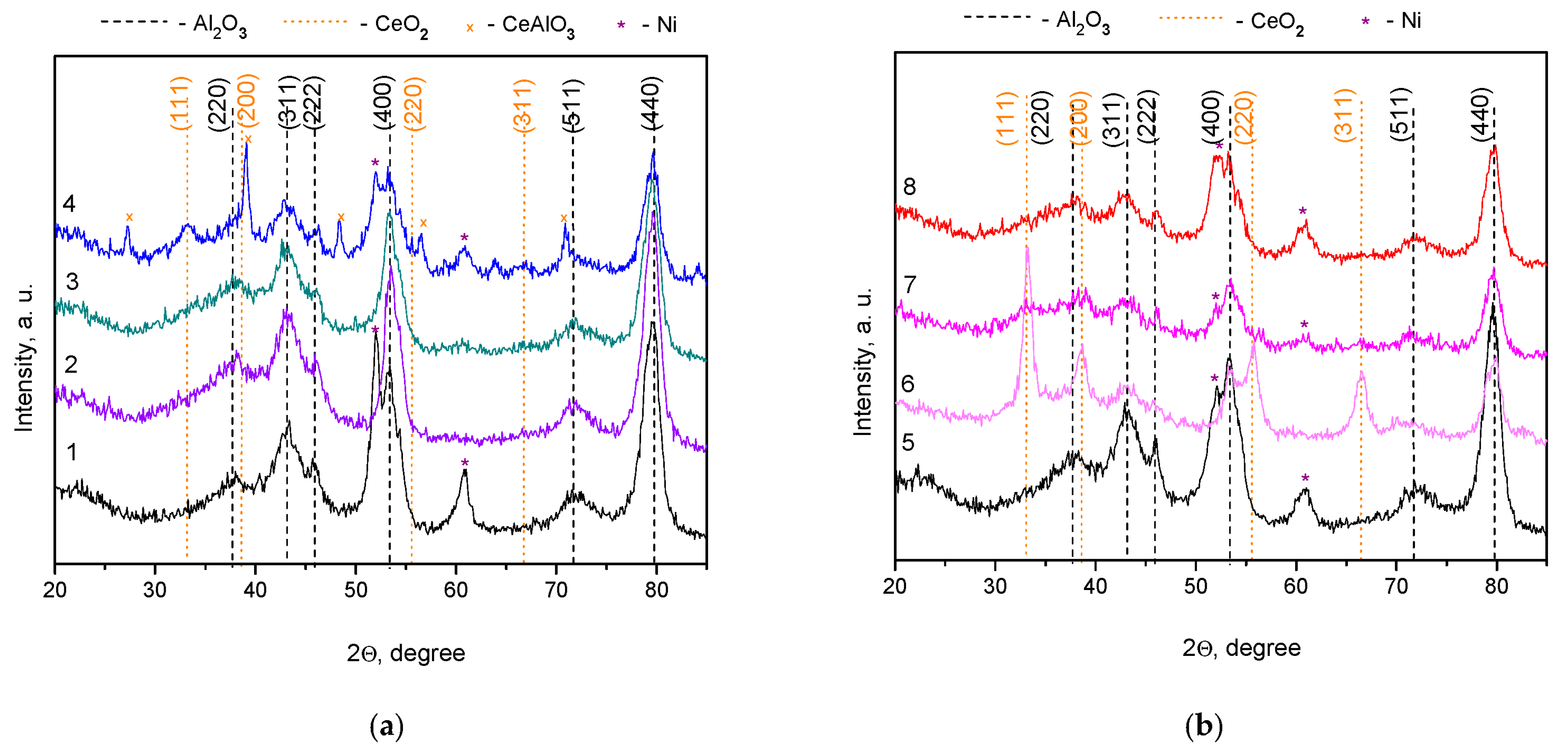
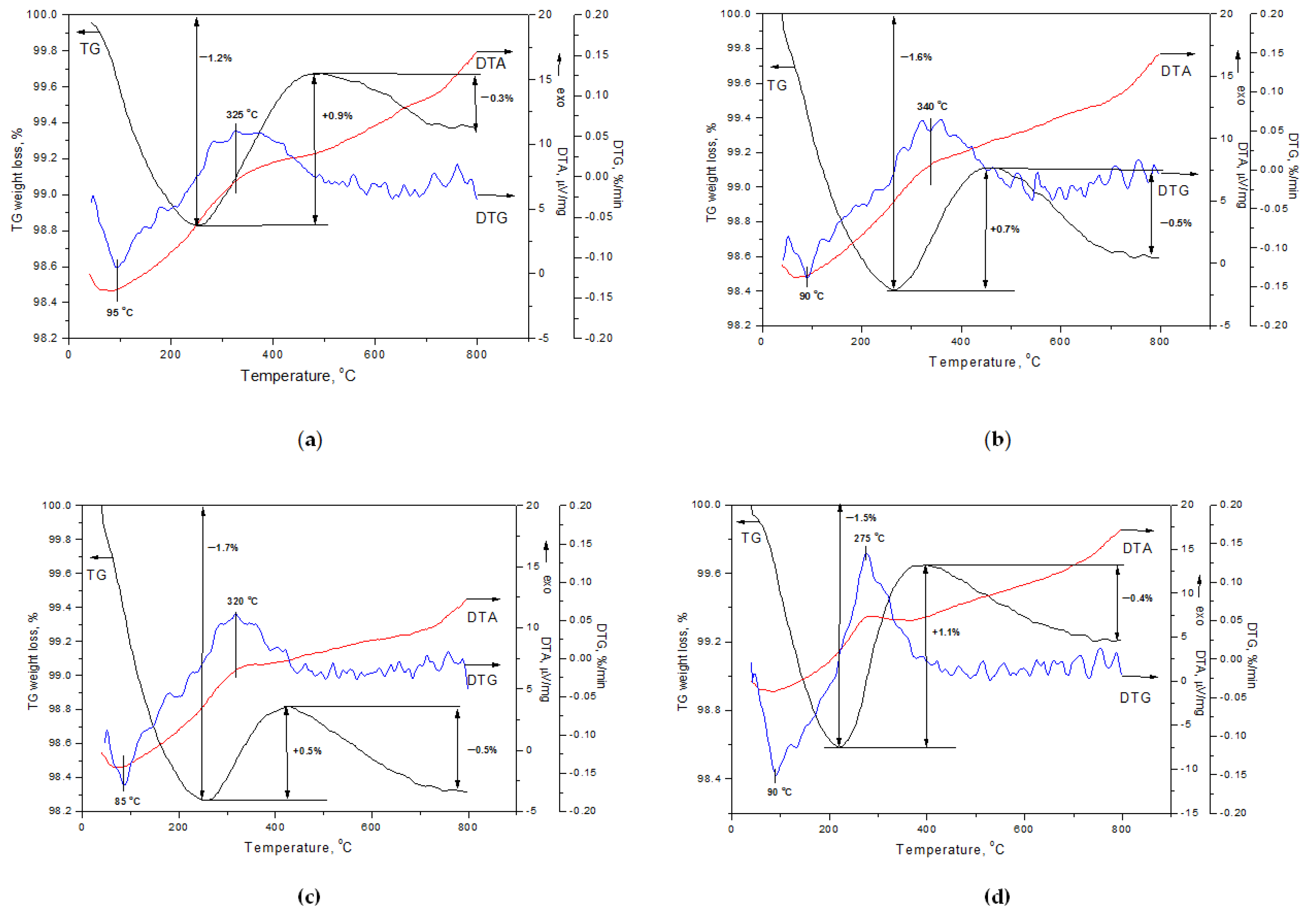
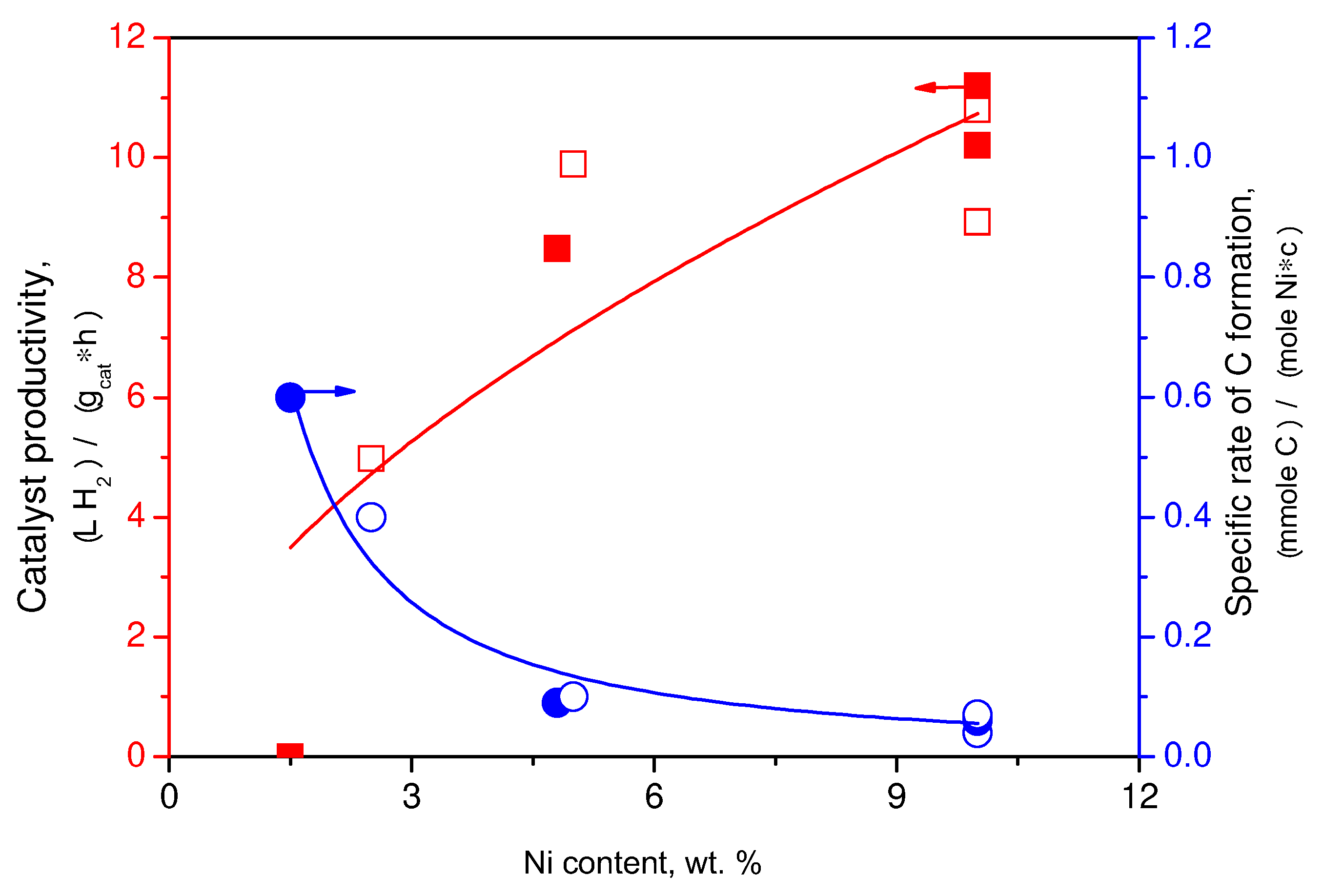
| Sample * | Chemical Composition, wt.% | Weight Loss (Δmi, %) at Different Temperature Ranges (ΔTi, °C) | Temperature of DTG Peak Maxima (TDTG ) and Type of Thermal Effect (exo/endo), °C | |||||
|---|---|---|---|---|---|---|---|---|
| Ni | Ce | Δm1 | Δm2 | Δm3 | T1 | T2 | T3 | |
| 10Ni/Al2O3-CI | 10.0 | 0 | 13.8 (25–220) | 10.5 (220–500) | 0.9 (500–1000) | 107 endo | 289 endo | – |
| 5Ce0.2Ni0.8O1.2/Al2O3-CI | 2.5 | 1.5 | 5.3 (25–170) | 7.4 (170–500) | 1.0 (500–1000) | 90 endo | 221 endo | – |
| 10Ce0.2Ni0.8O1.2/Al2O3-CI | 5.0 | 3.0 | n.d. ** | n.d. | n.d. | n.d. | n.d. | n.d. |
| 20Ce0.2Ni0.8O1.2/Al2O3-CI | 10.0 | 5.9 | 12.4 (25–170) | 16.4 (170–500) | 1.0 (500–1000) | 112 endo | 209 endo | 286 endo |
| 10Ni/Al2O3-SG | 10.0 | 0 | 14.5 (25–190) | 16.0 (190–500) | 0.8 (500–1000) | 115 endo | 251 exo | – |
| 20Ce0.8Ni0.2O1.8/Al2O3-SG | 1.5 | 14.7 | 9.1 (25–190) | 18.5 (190–500) | 0.8 (500–1000) | 112 endo | 212 exo | – |
| 20Ce0.5Ni0.5O1.5/Al2O3-SG | 4.8 | 11.4 | n.d. | n.d. | n.d. | n.d. | n.d. | n.d. |
| 20Ce0.2Ni0.8O1.2/Al2O3-SG | 10.0 | 5.9 | 14.7 (25–200) | 18.3 (190–500) | 1.2 (500–1000) | 128 endo | 242 exo | – |
| Sample | Type of Treatment | SBET, m2/g | Vp, cm3/g | Dp, nm | Phase Composition | Cell Parameter, Å | CSR, nm | I570/I465 |
|---|---|---|---|---|---|---|---|---|
| Al2O3 | O2/850 °C | 108 | 0.44 | 16.1 | (γ + δ)-Al2O3 | 7.909 | – | – |
| H2/800 °C | 105 | 0.43 | 16.5 | (γ + δ)-Al2O3 | 7.909 | – | – | |
| 10Ni/Al2O3-CI | O2/500 °C | 91 | 0.36 | 15.7 | (γ + δ)-Al2O3 NiO | 7.909 – | – 25.0 | – |
| H2/800 °C | 90 | 0.38 | 16.7 | (γ + δ)-Al2O3 Ni | 7.907 – | – 21.0 | – | |
| 5Ce0.2Ni0.8O1.2/Al2O3-CI | O2/500 °C | 99 | 0.39 | 15.8 | (γ + δ)-Al2O3 CeO2 | 7.914 – | – – | 0.85 |
| H2/800 °C | 87 | 0.39 | 17.8 | (γ + δ)-Al2O3 | 7.905 | – | – | |
| 10Ce0.2Ni0.8O1.2/Al2O3-CI | O2/500 °C | 95 | 0.38 | 16.3 | (γ + δ)-Al2O3 CeO2 | 7.914 5.410 | – 6.5 | 1.32 |
| H2/800 °C | 91 | 0.38 | 16.8 | (γ + δ)-Al2O3 | 7.905 | – | – | |
| 20Ce0.2Ni0.8O1.2/Al2O3-CI | O2/500 °C | 76 | 0.29 | 15.5 | (γ + δ)-Al2O3 CeO2 NiO | 7.913 5.410 – | – 7.5 10.0 | 1.31 |
| H2/800 °C | 71 | 0.31 | 18.0 | (γ + δ)-Al2O3 CeO2 Ni | 7.907 – – | – 6.5 6.5 | – | |
| 10Ni/Al2O3-SG | O2/500 °C | 96 | 0.33 | 13.7 | (γ + δ)-Al2O3 | 7.922 | – | |
| H2/800 °C | 91 | 0.38 | 16.9 | Al2O3 Ni | 7.907 – | – 13.5 | – | |
| 20Ce0.8Ni0.2O1.8/Al2O3-SG | O2/500 °C | 93 | 0.31 | 13.5 | (γ + δ)-Al2O3 CeO2 | 7.908 5.404 | – 25.0 | 0.36 |
| H2/800 °C | 79 | 0.31 | 15.6 | (γ + δ)-Al2O3 CeO2 | 7.900 5.422 | 10.5 | – | |
| 20Ce0.5Ni0.5O1.5/Al2O3-SG | O2/500 °C | 95 | 0.30 | 12.8 | (γ + δ)-Al2O3 CeO2 | 7.908 5.400 | – 5.5 | 1.19 |
| H2/800 °C | 78 | 0.29 | 14.8 | (γ + δ)-Al2O3 CeO2 | 7.913 5.400 | – – | – | |
| 20Ce0.2Ni0.8O1.2/Al2O3– SG | O2/500 °C | 89 | 0.32 | 14.2 | (γ + δ)-Al2O3 CeO2 NiO | 7.914 – – | – – – | 7.16 |
| H2/800 °C | 82 | 0.33 | 16.1 | (γ + δ)-Al2O3 Ni | 7.907 – | – – | – |
| Sample | SBET, m2/g | Vp, cm3/g | Dp, nm | Phase Compositions | Cell Parameter, Å | CSR, nm | Content of C, wt.% |
|---|---|---|---|---|---|---|---|
| 10Ni/Al2O3-CI | 88 | 0.37 | 16.6 | (γ + δ)-Al2O3 Ni | 7.919 – | – 9.0 | –0.3 |
| 5Ce0.2Ni0.8O1.2/Al2O3-CI | 94 | 0.40 | 17.0 | (γ + δ)-Al2O3 | 7.919 | – | –0.7 |
| 10Ce0.2Ni0.8O1.2/Al2O3-CI | 92 | 0.34 | 15.0 | (γ + δ)-Al2O3 | 7.919 | – | –0.4 |
| 20Ce0.2Ni0.8O1.2/Al2O3-CI | 81 | 0.32 | 15.8 | (γ + δ)-Al2O3 CeAlO3 Ni | 7.913 – – | – – 6.5 | –0.5 |
| 10Ni/Al2O3-SG | 86 | 0.34 | 16.0 | (γ + δ)-Al2O3 Ni | 7.919 – | – 6.0 | –0.5 |
| 20Ce0.8Ni0.2O1.8/Al2O3-SG | 74 | 0.32 | 17.3 | (γ + δ)-Al2O3 CeO2 | 7.908 5.413 | – 50.0 | –0.6 |
| 20Ce0.5Ni0.5O1.5/Al2O3-SG | 73 | 0.32 | 17.7 | (γ + δ)-Al2O3 CeO2 | 7.908 – | – – | –0.3 |
| 20Ce0.2Ni0.8O1.2/Al2O3-SG | 83 | 0.35 | 16.8 | (γ + δ)-Al2O3 Ni | 7.913 – | – 6.5 | –0.4 |
Disclaimer/Publisher’s Note: The statements, opinions and data contained in all publications are solely those of the individual author(s) and contributor(s) and not of MDPI and/or the editor(s). MDPI and/or the editor(s) disclaim responsibility for any injury to people or property resulting from any ideas, methods, instructions or products referred to in the content. |
© 2023 by the authors. Licensee MDPI, Basel, Switzerland. This article is an open access article distributed under the terms and conditions of the Creative Commons Attribution (CC BY) license (https://creativecommons.org/licenses/by/4.0/).
Share and Cite
Matus, E.; Kerzhentsev, M.; Ismagilov, I.; Nikitin, A.; Sozinov, S.; Ismagilov, Z. Hydrogen Production from Biogas: Development of an Efficient Nickel Catalyst by the Exsolution Approach. Energies 2023, 16, 2993. https://doi.org/10.3390/en16072993
Matus E, Kerzhentsev M, Ismagilov I, Nikitin A, Sozinov S, Ismagilov Z. Hydrogen Production from Biogas: Development of an Efficient Nickel Catalyst by the Exsolution Approach. Energies. 2023; 16(7):2993. https://doi.org/10.3390/en16072993
Chicago/Turabian StyleMatus, Ekaterina, Mikhail Kerzhentsev, Ilyas Ismagilov, Andrey Nikitin, Sergey Sozinov, and Zinfer Ismagilov. 2023. "Hydrogen Production from Biogas: Development of an Efficient Nickel Catalyst by the Exsolution Approach" Energies 16, no. 7: 2993. https://doi.org/10.3390/en16072993
APA StyleMatus, E., Kerzhentsev, M., Ismagilov, I., Nikitin, A., Sozinov, S., & Ismagilov, Z. (2023). Hydrogen Production from Biogas: Development of an Efficient Nickel Catalyst by the Exsolution Approach. Energies, 16(7), 2993. https://doi.org/10.3390/en16072993






